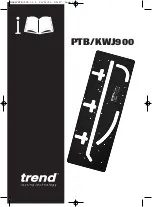
7 — English
SETTING THE DRIVE FORCE
See Figures 4 - 5, pages 9 - 10.
The depth adjustment knob increases or decreases the force
with which a staple is driven into the workpiece.
The drive force indicator, located on top of the tool, will
show the depth at which the staple will enter the workpiece.
Harder materials will require greater drive force.
Remove the battery pack.
Rotate the depth adjustment knob clockwise to increase
the drive force.
To test for desired depth, use a scrap piece of the same
material you will be using for your project.
WARNING:
Always keep your fingers away from the discharge area
of the tool when driving a staple and when using the ac-
cessory to install screen or wire. Failure to keep fingers
out of the way can result in serious personal injury.
DRIVING A STAPLE
See Figure 6, page 10.
Hold the handle firmly with the nose of the tool flat against
the workpiece at a 90° angle.
Press the activation foot of the stapler down against the
workpiece. The activation foot must be depressed before
pulling the switch trigger.
The tool will drive another staple each time the trigger is
depressed as long as the activation foot is depressed.
WIRE AND SCREEN ACCESSORY
See Figures 7 - 8, page 10.
The wire and screen accessory included with the stapler
is useful for attaching screen or wire to a wood frame or
workpiece. One accessory edge is used for fencing wire,
while the other edge is for attaching screen.
Drive a test staple in a scrap piece of the same material you
will be using for your project to test for desired drive force.
When not in use, the accessory may be stored on the tool
in the “STORE” position.
To install the accessory:
Remove the battery pack.
Select the desired application.
Turn the selected edge toward the nose of the tool.
Slide the accessory over the nose of the tool until it fits
into place over the tab on each side of the tool.
INSTALLING SCREEN
See Figure 9, page 10.
Install the accessory with the screen application edge
facing out.
Keeping your fingers away from the discharge area of
the tool, hold the screen in place on the surface of the
workpiece.
Press the activation foot of the stapler against the
workpiece, using a slight upward motion.
Pull the switch trigger to drive a staple.
INSTALLING WIRE FENCING
See Figure 10, page 10.
Install the accessory with the wire application edge facing
out.
Keeping your fingers away from the discharge area of the
tool, hold the wire fencing in place on the surface of the
workpiece.
Press the activation foot of the stapler against the
workpiece, making sure the wire is centered in the notch
of the accessory.
Pull the switch trigger to drive a staple.
REMOVING A JAMMED STAPLE
If there is a jammed staple in the tool, you must remove it
before further use. Attempting to drive a staple while the tool
is jammed could damage the mechanism.
Remove the battery pack.
Hold the tool upside down. Squeeze the magazine latch
and slide the magazine open.
Remove unused staples.
Remove the jammed staple with needle-nose pliers.
OPERATION
GENERAL MAINTENANCE
Avoid using solvents when cleaning plastic parts. Most
plastics are susceptible to damage from various types of
commercial solvents and can be damaged by their use. Use
clean cloths to remove dirt, dust, oil, grease, etc.
MAINTENANCE
WARNING:
When servicing, use only identical replacement parts.
Use of any other part could create a hazard or cause
product damage.
NOTE: ILLUSTRATIONS START ON PAGE 9 AFTER FRENCH
AND SPANISH LANGUAGE SECTIONS.
Summary of Contents for P317
Page 23: ...NOTES NOTAS ...







































